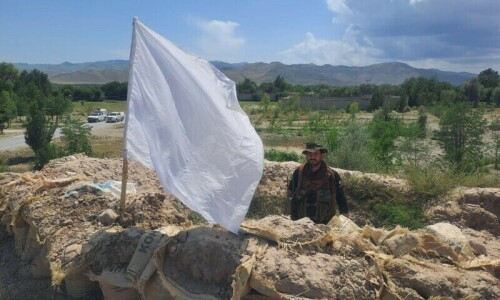
LIKE most of the world, I too am confined to the four walls of my home these days because of the unprecedented situation caused by the coronavirus pandemic.
However, this gives me a rare opportunity to recollect the accomplishments and traits of some of the stalwarts of the game who helped us make our mark as a cricketing nation of substance in the early days.
Amongst those who stood out during the formative years were figures such as Mian Mohammad Saeed, Pakistan’s first captain in the unofficial Tests, Abdul Hafeez Kardar who became the first captain to lead Pakistan in official Tests in 1951-52 after the ICC awarded the Test status to Pakistan, and of course, there was Little Master Hanif Mohammad, the scourge of all bowlers, the stylish Waqar Hasan and other men like Khan Mohammad and Munawar Ali Khan.
But one person who always caught my eye was the debonair Fazal Mahmood, a medium-fast bowler whose magnificent contribution in giving Pakistan a standing and a cricketing face is unforgettable.
A bowler of exceptional ability and skill, Fazal soon became the first Pakistan bowler to take 100 wickets or more in Tests. And believe me when I say that in my entire career as a journalist, I always rated him as one of the most handsome cricketers ever to step on a cricket field.
Tall, fair complexioned, broad shouldered with greenish eyes and a thick mop of hair covering his forehead, Fazal looked the part. He was very much I would say like Keith Miller of Australia, the greatest all-rounder of Don Bradman’s time who I also had the privilege to watch in Test cricket here in Pakistan, bowling in tandem with the great Ray Lindwall.
I was a bit unlucky when I missed Fazal bowl and take 6 wickets in the first innings of the 1951-52 unofficial Test against the MCC at Karachi Gymkhana which Pakistan won by four wickets and subsequently gained their Test status.
I had reached the ground quite late and managed to watch only the final session when Hanif and Kardar, in a solid stand, scored 64 and an unbeaten 50 to take Pakistan to victory. I was a schoolboy in Hyderabad at the time and had come to watch this match for a day and saw Fazal only from a distance, sitting in the pavilion.
Having made his first-class debut for Northern India in 1947-48 in Ranji Trophy, Fazal’s success with the ball had earned him selection for the Australia tour with India in 1948. But since Pakistan had come in to being, the Lahore born Fazal opted to remain in Pakistan.
In Pakistan’s inaugural Test series against India, later in 1952, he pulverised the Indian batting at Lucknow by taking 5 for 52 in the first innings and 7 for 42 on a matting wicket in the second to earn for Pakistan their first ever Test win and that too by an innings after losing the first Test at Delhi.
That was the match in which Nazar Mohammad scored 124 and carried his bat through. Fazal finished that first series with a haul of 20 wickets at 25.60
As a schoolboy I followed all that, and when at college, I followed his exploits on the England tour and his masterly display of swing bowling at The Oval in the final Test of the 1954 series in which he bagged 6 for 53 in the first and 6 for 46 in the second innings as England collapsed chasing 168.
Pakistan became the only country to draw their first ever series in England.
Until that time, I had not seen Fazal in flesh, bowling in a match. But that opportunity finally came in the 1954-55 Test against India at the National Stadium Karachi, the first Test ever played at the ground.
I had travelled from Hyderabad to see my first ever Test. Sitting at the University Road End at a rocky hill since there was no stands then in the ground, I watched Fazal bowl from that end with Khan Mohammad and Mahmood Hussain his fast bowling partners bowling from the other.
His was a heavy-footed run-up, a limping sort of approach to the wicket as he unleashed his deliveries — brilliant leg-cutters and in-swinging balls — that earned him 5 wickets for 48 in 28.3 overs and another wicket in the second innings. His victims were greats like Poly Umrigar, Vijay Manjrekar, Vinoo Mankad, Gulab Ramchand and Subash Gupte. His leg-cutters were hot stuff on a matting wicket and he was unplayable at times.
Soon after that Test I managed to see another one, against New Zealand at the same venue in Karachi which was followed by that memorable Test between Pakistan and Australia — the first between the two nations.
Having lost The Ashes in England in 1956 series, Australia had come to Karachi for a solitary Test which Pakistan won by 9 wickets. On a matting wicket only 95 runs were scored on the first day as Fazal mesmerised the Aussies with his leg-cutters to bowl them out for 80, capturing 6 for 34. He was even more lethal in the second innings, taking 7 for 80 to end the Test with 13 wickets. Another memorable sight for me in that game was to watch the great fast bowling pair of Miller and Lindwall bowl in tandem.
Fazal continued to excel on the West Indies tour of 1957 and later at home against them as well.
And then came the day when I got the first opportunity to face him in a first-class match was in 1960, when at Hyderabad’s famous Rani Bagh Ground I played for the Commissioner XI led by Hanif against the Fazal Mahmood XI.
Hanif’s youngest brother Sadiq Mohammad made his first class debut in that game.
In partnership with Hanif, I scored 26 while the Little Master made 76 as we faced Fazal in contrasting fashion. He beat me on a number of occasions off the leg-cutters and at that point, Hanif asked me to carefully watch his own footwork when facing Fazal which obviously helped me stay at the wicket a bit longer.
Son of a professor of economics at the Islamia College Lahore, Fazal finished with 139 Test wickets at 24.70 in 34 Tests. His 100th wicket came in his 22nd Test. He was named among the Wisden’s Five Cricketers of the Year in 1955 and was no doubt the pride of Pakistan.
Published in Dawn, April 20th, 2020












































Dear visitor, the comments section is undergoing an overhaul and will return soon.